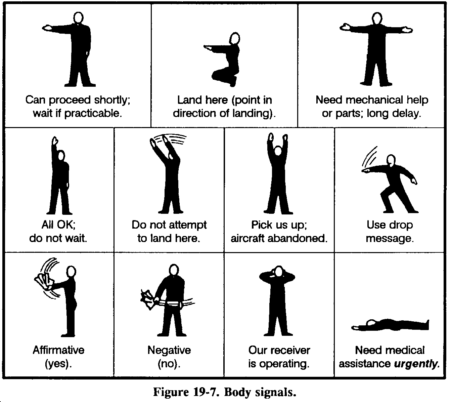CODES AND SIGNALS
Now that you know how to let people know where you are, you need to know how
to give them more information. It is easier to form one symbol than to spell out
an entire message. Therefore, learn the codes and symbols that all aircraft
pilots understand.
SOS
You can use lights or flags to send an SOS—three dots, three dashes, three
dots. The SOS is the internationally recognized distress signal in radio Morse
code. A dot is a short, sharp pulse; a dash is a longer pulse. Keep repeating
the signal. When using flags, hold flags on the left side for dashes and on the
right side for dots.
Ground-to-Air Emergency Code
This code (Figure
19-6) is actually five definite, meaningful symbols. Make these symbols a
minimum of 1 meter wide and 6 meters long. If you make them larger, keep the
same 1: 6 ratio. Ensure the signal contrasts greatly with the ground it is on.
Place it in an open area easily spotted from the air.
|
Number |
Message |
Code symbol |
| 1 |
Require assistance |
 |
 |
| 2 |
Require medical assistance |
 |
 |
| 3 |
No or negative |
 |
 |
| 4 |
Yes or affirmative |
 |
 |
| 5 |
Proceed in this direction |
 |
 |
Figure 19-6. Ground-to-air emergency code
(pattern signals). |
|
Body Signals
When an aircraft is close enough for the pilot to see you clearly, use body
movements or positions (Figure 19-7) to convey a message.

| Updated:
12 January 2008 |
|
Born on 14 December 1999 |



